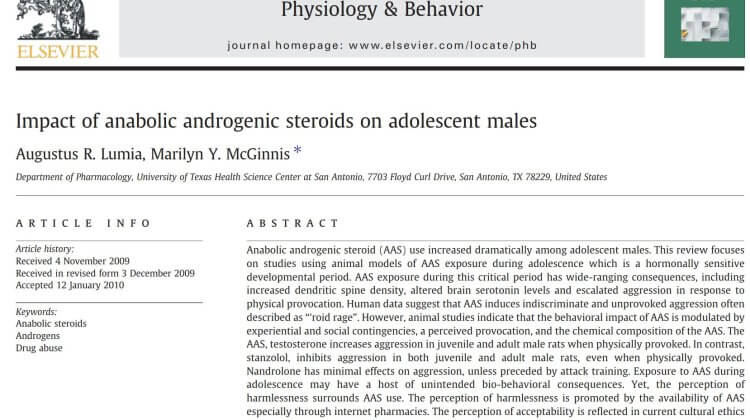
Once there was a time when the hallmarks of science were objectivity and dispassionate analysis. Serious men of science were unmoved by the political winds of the day, searching instead for enduring truths. Findings and conclusions flowed naturally, free of manipulation, from the data.
When it comes to anabolic steroids (AAS), that time is long gone, if it ever existed. Today, what passes for AAS research is mostly either funded by organizations with vested agenda-driven interests or conducted by researchers with preexisting negative attitudes and an interest in shaping policy. When objectivity and dispassionate analysis take a back seat, the literature becomes tainted with potentially misleading studies best described as “political” science.
A new review article published in Physiology & Behavior (Lumia AR, McGinnis MY, Impact of anabolic androgenic steroids on adolescent males, Physiol Behav (2010), doi:10.1016/j.physbeh.2010.01.007) appears to be another case in point. What’s wrong with the article? As a brief exercise, let’s simply dissect the title and abstract line by line.
The title of the article is “Impact of anabolic androgenic steroids on adolescent males.” Given all the media coverage of teen steroid abuse, you might reasonably conclude you’re going to read about research studies with high school teens as subjects. Not so. These “adolescent males” had four legs and tails. Yes, technically, pubescent male rats are “adolescent males.” But as to whether the omission of species was accidental or intentional, take note that the very first sentence in the abstract uses the exact same “adolescent males” in specific reference tohumanteenagers, not rats.
The first sentence of the body of the abstract asserts that “Anabolic androgenic steroid (AAS) use increased dramatically among adolescent males.” Mainstream media reports of a burgeoning epidemic of teen steroid use have continued unabated even recently. Although the article was received in revised form for publication in December 2009, the authors cite supporting references from 1988 – 1999. More recent statistics suggest quite the opposite. According to the University of Michigan’s “Monitoring the Future” studies of 8th, 10thand 12thgraders, there has been a precipitous drop in AAS use since 2000-2003. The percentage of 8thgraders (not gender-specific) who reported using steroids at least once in their lives went from a high of 3.0% in 2000 gradually down to 1.3% in 2009. Among 10thgraders, it went from 3.5% in 2000 gradually down to 1.3% in 2009. Among 12thgraders, the decrease was from a high of 4.0% in 2002 dramatically down to a steady 2.2% since 2007. By comparison in 2009, nearly three times as many 12thgraders have used ecstasy (6.5%, an increase over last year) and a whopping 56.5% have been drunk (also an increase over last year).
“This review focuses on studies using animal models of AAS exposure during adolescence which is a hormonally sensitive developmental period. AAS exposure during this critical period has wide-ranging consequences, including increased dendritic spine density, altered brain serotonin levels and escalated aggression in response to physical provocation.”
Indeed, adolescence is a hormonally sensitive period which sets the stage for the modeling of the adult brain and the development of adult male social behavior. But most animal-based work on AAS’ effects suffers from shortcomings that limit their application to humans. For instance, the doses administered are larger than is reported by a vast majority of adult human users. Additionally, they are often given continuously across the complete period of puberty, which in some animal species may constitute a matter of weeks but is equivalent to years of continuous human use. To take such research and directly apply it to human adolescence, as has been done numerous times, is quite a stretch. It may reflect what can happen given certain circumstances, but is unlikely to illuminate what does happen in typical non-medical use among humans.
“Human data suggest that AAS induces indiscriminate and unprovoked aggression often described as ‘’roid rage’.”
This is simply not an accurate characterization of the literature on human AAS use and aggression. Even those researchers who support a human AAS-aggression association and whose research these authors cite (e.g., Harrison Pope, MD) have noted the lack of scientific basis for the popular notion of “’roid rage” and admitted that if it exists at all, it is within a small fraction of the population of non-medical AAS users (and that some of these users likely had preexisting mental problems). The choice and placing of the word “often” in a sentence like this rather than something more accurate like “popularly” is curious. While intended to refer to the frequency of media labeling (not the frequency of the phenomenon itself), doesn’t a cursory overall reading of the sentence misleadingly suggest that this indiscriminate and unprovoked aggression is often induced?
“However, animal studies indicate that the behavioral impact of AAS is modulated by experiential and social contingencies, a perceived provocation, and the chemical composition of the AAS.”
At long last these authors note that the behavioral effects of AAS are not inevitable. Primate research (as opposed to rats) has shown that AAS do not always provoke aggression; in animals that are subordinate in the social hierarchy, they often induce submission. But, why not also mention that these same effects are also obvious in a review of the human AAS-aggression literature? Numerous authors and studies have highlighted the role of personality factors (such as impulsivity), status, and challenge in the relationship of testosterone and AAS use to aggression.
“The AAS, testosterone increases aggression in juvenile and adult male rats when physically provoked. In contrast, stanzolol [sic], inhibits aggression in both juvenile and adult male rats, even when physically provoked. Nandrolone has minimal effects on aggression, unless preceded by attack training.”
We’re only talking about rats here, but the authors are conceding that not all AAS have the same behavioral effects, and that at least one type of AAS actually reduces aggressive responses even when physically provoked!
“Exposure to AAS during adolescence may have a host of unintended bio-behavioral consequences.”
Of course this is true, and we are not condoning teen AAS abuse in any way whatsoever. In fact, any drug use among teenagers should be approached with caution and concern. Exposure to any of a wide range of drugs that affect hormone and neurotransmitter levels, whether licit and illicit, may have similar consequences, although there seems to be much less hyperbole surrounding licit use of drugs (e.g., off-label prescription of psychotropic medications) during this developmental period.
“Yet, the perception of harmlessness surrounds AAS use. The perception of harmlessness is promoted by the availability of AAS especially through internet pharmacies.”
Really? A perception of harmlessness? No one suggests that AAS do not pose potential harm for adolescents or, for that matter, that they are harmless drugs no matter who is using them, particularly without medical supervision. They are not. But the media presentation of AAS has been relentlessly negative in virtually every context. If anything, the harms associated with AAS use have been routinely sensationalized and exaggerated by mainstream information sources. And one thing we do know; teens (especially males) tend to see themselves as largely immune to such negative effects. In fact, some of the effects that scientists consider negative may not be seen as such by adolescents. Citing the advertisements of rogue online pharmacies to justify a generalized perception of harmlessness is simply silly.
“The perception of acceptability is reflected in current cultural ethics that no longer condemn cheating to obtain personal achievement or success. A prevailing conviction is that although AAS are illegal they are not really bad.”
Here the authors continue to deviate from any role as scientists or researchers, launching instead into a lamentation about a cultural loss of ethics as a basis for driving policy in the area of AAS. It may be that cheating in general is tolerated more than it should be. But the acceptability of any means to that end does not serve to indict the drug itself, but the society. We need look no further than the ongoing coverage of the Winter Olympic Games to see that the preeminence of the spirit of competition pales in comparison to the medal count.
“Reduction of the availability of AAS to adolescents requires ardent legislative and legal intervention.”
There’s nothing wrong with constantly exploring new ways to reduce the availability of drugs of all kinds to teens, but the dramatic reduction in teen AAS use confirms that the current legislative and enforcement initiatives are working.
“The problem of acceptability can be addressed by educating adolescents about the short-term and long-term effects of AAS on brain and behavior, to increase awareness of the potential consequences of AAS use that apply directly to them.”
Delaying adolescent experimentation with any and all illicit and potentially harmful drugs is a laudable goal; research shows that among those who use drugs, the older they are when they start the less likely they are to have drug-related problems later in life. Preventing, delaying or reducing adolescents’ use of any and all illicit drugs is desirable. Efforts such as education seem appropriate, although data suggest that they have limited success unless they also offer viable alternatives for reaching the goals inherent in such use. More importantly, data show that scare tactics using over-stated, low base-rate, catastrophic outcomes such as those presented in this article do little to impact impressions of harmfulness while they increase perceptions that science is being used to drive an agenda. Accurate information that can inform young people who are contemplating use and can reduce the harm for those who have decided to use would seem the appropriate course.
About the author
Warning: Undefined array key "display_name" in /home/thinksteroids/public_html/wp-content/plugins/molongui-authorship-pro/includes/hooks/author/box/data.php on line 11
Warning: Undefined array key "display_name" in /home/thinksteroids/public_html/wp-content/plugins/molongui-authorship-pro/includes/hooks/author/box/data.php on line 11
Warning: Undefined variable $show_related in /home/thinksteroids/public_html/wp-content/plugins/molongui-authorship/views/author-box/parts/html-tabs.php on line 30


Leave a Reply
You must be logged in to post a comment.